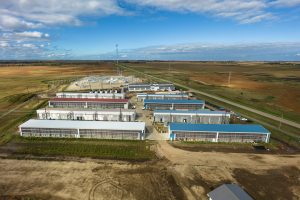As the Securities and Exchange Commission (SEC) steps back from defending its March 2024 Climate Disclosure Rule, companies face growing uncertainty in navigating an increasingly fragmented and uncertain landscape of state and international mandates—with no uniform standards in sight. This development signals a broader shift under the Trump administration, which has prioritized deregulation, withdrawn support for federal disclosure mandates, and signaled opposition toward state-level requirements. The resulting regulatory divide leaves companies with a patchwork of emerging rules and limited guidance on how to harmonize compliance across jurisdictions.
Federal Government Sues Four States Over Climate Superfund Laws and Climate Change Litigation
The U.S. Department of Justice (DOJ) has filed a series of federal lawsuits against four states—New York, Vermont, Michigan and Hawaii—alleging that recent legislative and enforcement efforts to hold fossil fuel companies financially responsible for climate change unlawfully interfere with federal authority. The lawsuits, filed on April 30 and May 1, challenge two distinct forms of state-led climate action: (1) enacted climate superfund statutes in New York and Vermont, and (2) announced plans by Michigan and Hawaii to bring climate change litigation against fossil fuel companies under state tort law.
PFAS, HFCs and Related Chemicals in the Data Center Industry
Data centers use various chemicals that have recently been the focus of regulatory efforts at the federal and state level. The historic or future use of these chemicals may create liabilities, obligations, or new costs for both existing and planned data centers.
Designing, Constructing and Converting Data Centers and Crypto Mines
 The ever-increasing demand for digital infrastructure, coupled with continuing cryptocurrency demand volatility, has generated significant interest in transforming building improvements housing crypto mining farms into modern high-capacity data centers. Crypto mines and data centers share certain foundational elements—facilities with a large footprint and the need for high power capacity and cooling—but they have different functions, and their operational models, technical requirements and regulatory considerations are correspondingly diverse. Below are some key distinctions between the two, as well as issues developers should anticipate, when designing and constructing either type of facility, or considering a crypto farm-to-data center conversion.
The ever-increasing demand for digital infrastructure, coupled with continuing cryptocurrency demand volatility, has generated significant interest in transforming building improvements housing crypto mining farms into modern high-capacity data centers. Crypto mines and data centers share certain foundational elements—facilities with a large footprint and the need for high power capacity and cooling—but they have different functions, and their operational models, technical requirements and regulatory considerations are correspondingly diverse. Below are some key distinctions between the two, as well as issues developers should anticipate, when designing and constructing either type of facility, or considering a crypto farm-to-data center conversion.
Environmental Update: Regulatory Notes – April 2025
April has proven a busy month for environmental issues when it comes to the regulatory arena. Below are just a few of the notable developments:
Presidential Memo Directs Immediate Repeal of Regulations Without Public Notice and Comment
Continuing with the Trump administration’s deregulatory agenda, the White House issued a Presidential Memorandum on April 9 titled Directing the Appeal of Unlawful Regulations. It instructs executive agencies to repeal regulations that, in the administration’s view, are “unlawful” in light of 10 recent U.S. Supreme Court decisions. The directive builds on Executive Order 14219 and the broader “Department of Government Efficiency” initiative and calls for a sweeping review and repeal process.
Real Estate & Construction News Roundup (4/16/25) – Multifamily Construction Opportunities, a Tariff Timeout for Commercial Developers and Data Center-Driven Real Estate Boom
In our latest roundup, REITs ramp up development, U.S. water infrastructure funding plateaus, Giant’s mixed-use development raises questions, and more!
U.S. Department of Energy Pursues Data Centers on Federal Lands
On April 7, the Office of Policy for U.S. Department of Energy (DOE) published a Request for Information (RFI) seeking input from industry professionals, grid operators, local communities, Tribal governments, and other stakeholders regarding the development and operation of AI infrastructure—including data centers—on DOE-owned or managed lands. This initiative aligns with the January 2025 Executive Order, Removing Barriers to American Leadership in Artificial Intelligence, which underscores AI as a national and economic security priority. DOE is hoping the RFI provides information that allows it to better understand site interest, strategic data center design approaches, potential power needs, financial and contractual considerations related to leasing DOE-owned or managed lands, and the potential benefits and challenges associated with hosting AI infrastructure on DOE land.
Real Estate & Construction News Roundup (4/2/25) – U.S. Banking’s CRE Exposure, Increased Insurance Challenges and an Embrace of AI by Construction Firms
In our latest roundup, the Tampa Bay Rays pull out of a stadium deal, the National Association of Realtors examines another policy change, energy efficiency measures continue to lower operating expenses, and more!
Making the Opportunity Zones Program Great at Last
The opportunity zone tax program was introduced during President Donald Trump’s first term as part of the 2017 Tax Cuts and Jobs Act. Its main goal was to encourage investments in economically distressed areas by offering specific tax benefits. By boosting local development, increasing tax revenue and creating jobs, the opportunity zone program quickly became a focal point for real estate and community development, although it also faced criticism.




